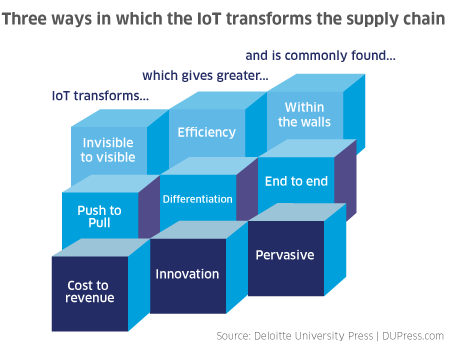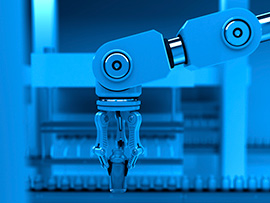Digital Supply Chain: Lead, Follow or Get Out of the Way
An ever-growing bevy of new IoT-enabled technologies has ignited a digital business revolution that is fundamentally, and irrevocably, transforming the relationship between people, processes, data and things and supply chains are on the front line of the battle. It’s time for supply chain professionals to choose: be a disruptor or a disruptee.
Just when you start getting comfortable with the idea of digital business disruption, a new wave of innovation-driving technologies comes along to push you right back into technology overload. At the Symposium/ITxpo 2015 earlier this month, Gartner identified what it predicts will be the top 10 strategic technology trends shaping digital business opportunities through 2020. The “algorithmic economy,” “device mesh,” and “ultra-efficient neuromorphic architectures” are just a few of the emerging IoT trends that are expected to further drive the fundamental transformation of the relationship between people, processes, data and things.
The challenge facing supply chain professionals is how to best leverage these technologies to fulfill what Gartner terms, their “bimodal” mandate, as both corporate “growth partner and operational caretaker.” Developing and maintaining the systems and processes needed to model a digital supply chain capable of increasing productivity, delivering more value and creating better customer experiences is a monumental effort that no one functional organization can expect to manage on its own. It requires buy in and collaboration with both internal stakeholders and external supply chain partners—upstream and down.

All or Nothing?
So, where do you start? Within the analyst community, there are generally two trains of thought about how best to approach this mission. In its report, The Digital Supply Network: A New Paradigm for Supply Chain Management, management consulting firm Accenture posited that “piecemeal digitization of supply chain elements is counterproductive,” and likened the effort to a contractor trying to “construct new buildings on old foundations: re-fitting, re-wiring and re-adapting instead of re-inventing.” The result, they say is “reams of inconsistent, redundant data; myriad inefficiencies; and (most important) huge amounts of unrealized performance potential.”
“A wholesale re-invention of the supply chain as a fully digital, integrated supply network may be the ideal scenario, it is generally not a realistic expectation”
While a wholesale re-invention of the supply chain as a fully digital, integrated supply network may be the ideal scenario, it is generally not a realistic expectation for a large portion of the electronic component supply chain. “The disruptive nature of IoT is driving many to portray it as a driver for business and supply chain transformation. And it can be,” according to the Gartner report, Five Ways the Internet of Things Will Benefit the Supply Chain. However, “it can also drive incremental benefits to existing supply chain processes spanning asset utilization, warehouse space optimization or production planning”
Making the Invisible Visible
 For supply chain professionals, IoT-based technologies enabling the capture and analysis of real-time operational data represent an opportunity to do what was once thought impossible: make the invisible visible. Whether its transparency of products moving through a supply chain, conditions on a factory floor, manufacturing energy consumption or end user preferences, within the enterprise or across the globe, the data collected and the information it begets are the “fuel that is driving the whole idea of digital supply chain,” said Tom Linton, chief procurement and supply chain officer for Flextronics at the company’s 2015 Analyst Day meeting.
For supply chain professionals, IoT-based technologies enabling the capture and analysis of real-time operational data represent an opportunity to do what was once thought impossible: make the invisible visible. Whether its transparency of products moving through a supply chain, conditions on a factory floor, manufacturing energy consumption or end user preferences, within the enterprise or across the globe, the data collected and the information it begets are the “fuel that is driving the whole idea of digital supply chain,” said Tom Linton, chief procurement and supply chain officer for Flextronics at the company’s 2015 Analyst Day meeting.
Flextronics, like other high-tech giants including Intel, Cisco and GE, has taken Accenture’s “go big, or go home” approach to its digitization efforts. Flex has invested in 3D manufacturing technology, increased the use of automation and robotics in its factories and developed a proprietary cloud-based supply chain tracking software, which is now being marketed by a company called Elementum.
“You can’t move what you can’t see. So we believe that building capability around visibility is really critical to making a supply chain faster and more intelligent”
The crown jewel in the Flex digital supply chain transformation, however, is the “situation room,” located within its Silicon Valley Innovation center. The room features a wall of 22 touch-screen panels offering a visual representation of the entire Flex supply chain, drawn from the live-streaming data of systems including inventory monitoring, manufacturing, quality, outbound transportation and delivery.
“You can’t move what you can’t see. So we believe that building capability around visibility is really critical to making a supply chain faster and more intelligent.” And, more profitable. Linton explained that for Flextronics, a typical production cycle operates at 55 days and equals $3.5 billion worth of inventory. If, using real-time information, Flex can accelerate its production cycle by just one day, the benefits in terms of asset velocity benefit and speed of a supply chain would be equal to $65 million cash.
It’s a Start
Those without the reach and resources of a multinational billion-dollar enterprise should not let the enormity of the Industrial Internet trigger analysis paralysis. A slow, but steady, application of digital enablers in existing business processes can also boost effectiveness and, in the long run, prove transformative for the business. Success, according to the McKinsey & Company report Raising your Digital Quotient, “depends on the ability to invest in relevant digital capabilities that are well aligned with strategy.”
For those who must, or choose to, take a more incremental approach to digitization, manufacturing and logistics are two functions at the heart of many digital capabilities that offer an array of adoption options.
For example, the DHL report on the Internet of Things in Logistics stated that cloud-based GPS and Radio Frequency Identification (RFID) technologies can enable connected pallets to transmit their location and the condition of their shipment, providing valuable in-transit visibility.
You can ignore additive manufacturing, but others will not, and at a certain point the technology will breakout in your industry and you will be unprepared to compete
Additive manufacturing also represents a potentially valuable vehicle to improve supply chain performance, said Mark Cotteleer, research director with Deloitte Services LP. Among the benefits additive manufacturing can have on supply chains are reduced material waste, increased production flexibility and the ability to decentralize production.
 While 3D printing is most commonly associated with fast prototyping, the technology has evolved considerably in recent years to include a broad array of new processes and materials. An advantage for smaller manufacturers is that there are a variety of ways 3D printing can be introduced into the manufacturing chain, including tooling, maintenance and support, without the need for radical change, he noted.
While 3D printing is most commonly associated with fast prototyping, the technology has evolved considerably in recent years to include a broad array of new processes and materials. An advantage for smaller manufacturers is that there are a variety of ways 3D printing can be introduced into the manufacturing chain, including tooling, maintenance and support, without the need for radical change, he noted.
“Additive manufacturing is like many other innovations that have swept through manufacturing,” said Cotteleer. “You can ignore it for a long time; but others will not, and at a certain point the technology will break out in your industry and you will be unprepared to compete.”
That breakout may be coming sooner than many expect. A recently released Gartner report forecasts that the total number of 3D printers purchased per year will increase from more than 106,000 units in 2014 to more than 5.6 million units in 2019—a CAGR of 121.9 percent.
Game On
With a value-at-stake of more than $8T over the next 10 years, this rise of the machines is not likely to lead to a stereotypical sci-fi pitting of man vs. machine. Rather, the digital business revolution is about augmenting the capability of both, said IBM CEO Ginni Rometty during her keynote address at the Gartner Symposium/ITxpo. “Together, man and machine can perform better than either one can on their own.” Whether or not one accepts this concept will be the difference between becoming a disruptor or a disruptee, she concluded.
Here’s a preview of some insights in this section from supply chain thought leaders on the technologies, opportunities and implications of the digitization of the supply chain:
- Alex Iuorio, senior vice president of supplier management and business development for Avnet Electronics Marketing, IoT Proliferation Teeters on the Edge: “Cloud technologies and the Internet of Things make it very difficult for organizations to define, and therefore defend, the ‘edge’ of their enterprise.”
- Octopart co-founder Sam Wurzel, One-Click Manufacturing: Could It Really Be That Easy: “OCM can provide a significant time-to-market advantage, particularly for hardware startups competing against large, entrenched players.”
Related Resources:
- Report: The Digital Supply Network: A New Paradigm for Supply Chain Management,
- Report: A Conceptual Framework for Digital Business Transformation
- Report: 3D opportunity for the supply chain
- Initiative: The Global Center for Digital Business Transformation
- Article: How Can I Secure My Digital Supply Chain?
- Article: Objects That Change Shape On Their Own
